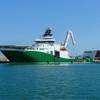Dry Bulk Market Looks Dull
Global dry bulk fleet utilization (calculated as total demand in tonne miles transported divided by total available fleet capacity) dropped by 1.4% in the fourth quarter of 2018, reflecting the trend observed in the rate environment.
According to Norway based dry bulk shipping company Golden Ocean Group, freight rates in the fourth quarter of 2018 disappointed compared to expectations, in particular for the Capesize vessels, which declined from the previous quarter.
The Panamax and Supramax markets were relatively unchanged from the previous quarter, it said.
According to Maritime Analytics, global fleet utilization was 85.8% in the fourth quarter of 2018, down from 87.2% in the third quarter of 2018 and 86.7% in the fourth quarter of 2017.
According to the same source, total seaborne transportation of dry bulk goods was 1,147 mt in the fourth quarter of 2018, compared to 1,178 mt in the third quarter of 2018 and 1,115 mt in the fourth quarter of 2017. This 2.7% yearover-year growth in transported volumes was largely offset by growth in available vessel supply.
Golden Ocean Group said that the global fleet of dry bulk vessels amounted to 830 million dwt at the end of 2018. Deliveries in the fourth quarter of 2018 were 5.3 million dwt, down from 7.0 million dwt delivered during the third quarter of 2018.
Total deliveries amounted to 28.1 million dwt in 2018, which is equivalent to 3.5% fleet growth from the start of the year. Looking ahead, the total orderbook was 95.3 million dwt, or approximately 11.5% of the capacity on the water, as of the end of 2018. This represents a 0.5% increase from the start of the fourth quarter.
Vessels scheduled for delivery in 2019 is estimated to be 6% of the sailing fleet. This includes several orders placed in 2015 or earlier totaling more than 13.0 million dwt. Part of this volume is likely not to be delivered. If market weakness persists, one can reasonably expect further delays and cancellations, and the final volume delivered for 2019 could be closer to the volumes from last year.
Scrapping increased slightly in the fourth quarter of 2018 to 1.0 million dwt, up from 0.6 million dwt in the third quarter of 2018.
According to Simpson Spence Young, 4.8 million dwt in total was scrapped during 2018, which represents 0.6% of the fleet at the start of the year. This is by far the lowest annual volume scrapped in over 10 years.
Given the current weak market and the implementation of ballast water regulations this September followed by the low sulphur fuel regulations in 2020, we expect to see a short term pickup in scrapping, which should provide some support to the market.
Activity in the sale and purchase market increased slightly in the fourth quarter of 2018, but asset prices were largely unchanged, and activity has been limited following the drop in rates. Newbuilding prices have remained consistent, although the pace of orders has slowed somewhat. Most of the recent orders have been placed by leasing companies rather than owners.












